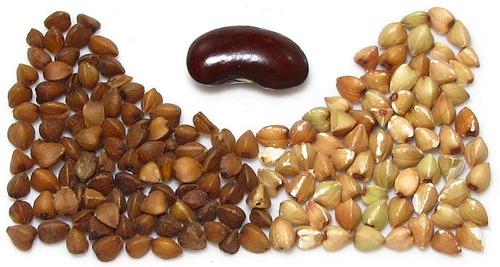 [Gretchka (Russia), Fagopyrum esculentum]
[Gretchka (Russia), Fagopyrum esculentum]
These tiny three sided pyramidal seeds, about 0.15 inches long, are incorrectly called "kasha" in the U.S. - in Russia "kasha" is any grain cooked to a porridge consistency. Buckwheat was so important to Russians that an early Russian Olympic team, when they found they couldn't get grechnevaya kasha in Paris, packed up and went home.
Buckwheat grows well under harsh conditions. After the revolution, Russian Communists, as part of their Westernization program, forced replacement of buckwheat crops with "more modern" wheat, resulting in considerable starvation in regions not particularly favorable for growing wheat.
Buckwheat is sold as "groats", the edible part of the seed after the fibrous hull has been removed. The photo shows roasted groats to the left, the way they're usually sold in the U.S. and unroasted to the right. Buckwheat is also sold ground into flour, which is mixed with wheat flour to make buckwheat pancakes in the U.S. and soba noodles in Japan.
Buckwheat greens are toxic to humans, but sprout enthusiasts do sprout the seeds and eat them at four to five days of growth. Buckwheat is also sprouted and malted to make gluten free beer for those allergic to gluten.
The hulls left from making groats are often used as upholstery filling and to fill pillows for people allergic to feathers. Buckwheat hulls are durable and have better heat transfer properties than synthetics.
More on Buckwheats & Sorrels.
Buckwheat grows in high altitude regions and regions with a short growing season where wheat does not thrive. It remains important in Tibet, northern China, Siberia, Russia, Ukraine, Poland, Korea and Japan. It is most used as noodles in East Asia, but as groats in Europe and Western Asia. In the West it is also often used to make crepes and pancakes, alone or mixed with wheat flour.
Buckwheat flour is very scarce in supermarkets but is easily available from on-line sources and specialty markets. It should be purchased from a high volume source or directy from mills due to it's perishability.
Traditionally, the roasted buckwheat would be put in a greased casserole with the water, salt and usually some butter on top. This would go into a preheated 350°F/175°C oven for 45 minutes. This method approximates baking in the ashes of an old Russian stove.
Here in Southern California we don't heat up an oven unless we really need to, so buckwheat is more often done just like steaming rice, in a tightly covered sauté pan over very low heat. Preparation is the same as for oven cooking.
While rare, allergic reactions to buckwheat have been reported from Korea, Japan and Europe.
cb_buckz 070319 - www.clovegarden.com